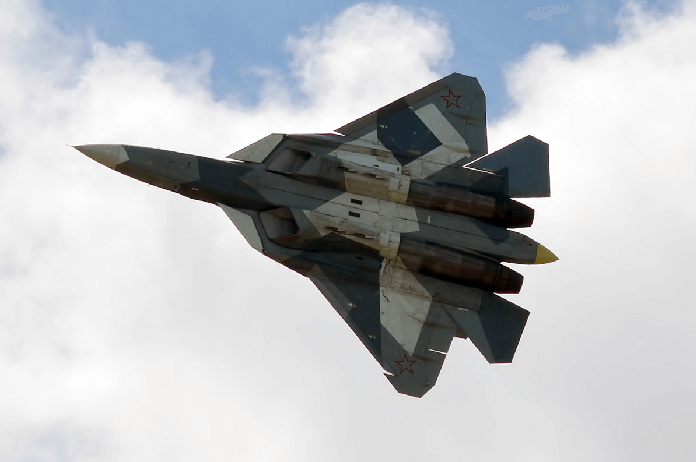As bonhomie between Russia and China continues to grow especially against US assertiveness against both the nations, there are reports that Beijing could be acquiring the Russian, fifth-generation, stealthy, and the most potent warplane in the Russian armory – the Su-57 jets.
Double Trouble: Massive Russian Transport Aircraft Skids Off The Runway After Engine Failure: Watch
According to reports in Chinese state media the Global Times (GT), military experts in the world’s second-biggest economy are becoming increasingly convinced about the competence of Su-57 warplanes but also remain skeptical if the Russian jets can integrate into the Chinese system since China has developed its own stealth jets – the J-20s.
GT citing the Jane’s Defense Weekly writes – the Su-57E, an export version of the Su-57, is expected to receive export approval from Russian President Vladimir Putin in a few weeks, said Viktor Kladov, director of international cooperation and regional policy at Russia’s Rostec defense industrial holding company, at a media briefing at the Langkawi International Maritime and Aerospace Exhibition in Malaysia.

Kladov termed China as a potential customer. “China has recently taken delivery of 24 Su-35 aircraft, and in the next two years [China] will make a decision to either procure additional Su-35s, build the Su-35 in China, or buy a fifth-generation fighter aircraft, which could be another opportunity for the Su-57E,” he said.
Xu Guangyu, a senior consultant at the China Arms Control and Disarmament Association, told the Global Times that it is likely that China could acquire the Russian Su-57s as Beijing needs to analyze and learn from other countries, whenever possible.
Wang Yongqing, the chief designer of the Shenyang Aircraft Design Institute said that the Su-57 is designed to have powerful supersonic cruise and maneuverability, and intentionally reduces stealth, a capability said to be crucial to a fifth-generation fighter, the GT wrote in its report.
While US warplanes focus on stealth and beyond visual range missiles, the Su-57 can dodge incoming hostile missiles through its super-maneuverability and engage enemies at close range, a situation where stealth is not so significant as super-maneuverability, Wang said.
India could also be keen in acquire the Su-57 jets, Kladov said. Unlike China, India does not have a fifth-generation warplane and will not be able to develop one anytime soon, so the Su-57 is a very attractive option for India, Wang Ya’nan said.
The twin-engine for SU-57 is built at the Komsomolsk-on-Amur aircraft plant in the Russian Far East. According to a report in Forbes by David Axe, Sukhoi originally planned to hand over the first two production-standard SU-57s in late 2019 and two more in 2020. But the December 2019 crash of one of the jets compelled the company to halt the work on the program.
As reported earlier by the EurAsian Times, the SU-57 fighter jet is designed to have supercruise, supermaneuverability, stealth, and advanced avionics to overcome the prior generation fighter aircraft as well as ground and naval defenses.
Russia is marketing a number of high-end combat jets to India and alongside continued sales of MiG-29 and SU-30MKI fighters. New Delhi could also possibly purchase the Yak-130 fighter-trainer and the MiG-35 next-generation medium fighter jet.
India has shown some interest in Russia’s Su-57 next-generation heavyweight fighter, although the aircraft is yet to enter service in the Russian Air Force. New Delhi is likely to wait and assess its performance before giving any assurances.
Experts stated that the possibility remains that India could seriously consider acquiring an initial batch of ‘off the shelf’ Su-57 jets from Russia to evaluate their capabilities – before entering into a contract for joint production.




